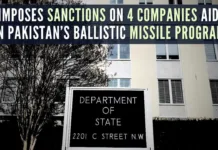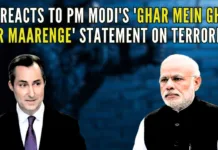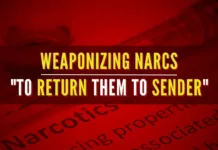
This is the concluding part of our series on Pakistan desperately flogs dead letter ‘K’ to rekindle international interest in Khalistan, Kashmir? Part 1 can be accessed here and Part 2 here.
Pakistan’s periodic flogging of the other dead ‘K’ horse – or Kashmir’s self determination is a joke that cannot evoke even a smile any longer.
It had begun with a hurrah some 70 years ago.
[dropcap color=”#008040″ boxed=”yes” boxed_radius=”8px” class=”” id=””]I[/dropcap]n 1947, the newly created state of Pakistan tried to take Kashmir saying the valley had majority Muslims. The assault was on the basis of the logistic axiom that the road access to J & K had ended up in Pakistan. White men in charge of defence on either side of the border took a decision to start the so-called ‘Kashmir skirmish’.
The British had created the non-existent borders and the war. The idea was to create a permanent dispute between India and Pakistan over the princely state of Jammu and Kashmir, bleed all the three and sell arms.
On the Pak side, it was General Douglas Gracey.
In 1947 Gracey became Chief of the General Staff and Deputy Commander-in-Chief of the Pakistan Army before succeeding Frank Messervy as Commander-in-Chief of Pakistan’s armed forces.
Gracey refused to obey Mohammad Ali Jinnah, Governor General of Pakistan saying Jinnah as Governor-General represented the British Crown of which he himself was an appointee.
On the “Indian” side, the commanders-in-chief between 1947 and 1948 were – Sir Robert Lockhart and Sir Roy Bucher.
[dropcap color=”#008040″ boxed=”yes” boxed_radius=”8px” class=”” id=””]T[/dropcap]he British had created the non-existent borders and the war. The idea was to create a permanent dispute between India and Pakistan over the princely state of Jammu and Kashmir, bleed all the three and sell arms. Indian stalwarts like Vallabh Bhai Patel and Rajagopalachari saw through the game and got the then J & K monarch Maharaja Hari Singh to sign on the dotted line – annexing his kingdom with India irrevocably.
One 100 years after Guru Gobind Singh turned Sikhs into a war-like tribe, Maharaja Ranjit Singh completed the task and created the city of Lahore – as its capital between 1799 and 1839.
Indian troops were airlifted to Srinagar and our soldiers stopped the Pak advance around what is now known as the Line of Actual Control.
Even as the United Nations forced a ceasefire the then Prime Minister of India, Jawaharlal Nehru, needlessly announced that the people of undivided J & K would decide their destiny vide an referendum [plebiscite] supervised by the UN.
The colonial British had a simple set of angles linking the 2 ‘K’s.
Guru Gobind Singh’s father Guru Tegh Bahadur had been invited by several Kashmiri Pandits to turn Sikhs to resist forced conversion to Islam.
Guru Tegh Bahadur chose death instead of conversion to Islam.
One 100 years after Guru Gobind Singh turned Sikhs into a war-like tribe, Maharaja Ranjit Singh completed the task and created the city of Lahore – as its capital between 1799 and 1839. After his death, a series of betrayals on the side of the Sikhs resulted in the British East India Company gaining an upper hand through the first Anglo-Sikh war declared on December 13 1845 by Lord Hardinge.
From March 1846, Britain began having a say over every political event in the Punjab. A demand of Rs.1.5 crore made by the British was too steep for Punjab to pay and they ceded Hazara and Kashmir to the crown for Rs.1 crore. In turn, the monarch of Jammu, Gulab Singh “purchased” Kashmir for Rs.75 lakhs from the British. In 1849, after the ‘complete conquest’ of the Punjab, ‘emperor’ Duleep Singh bequeathed all rights to the whites and chose to remain a titular head. He also gave away the Koh-i-Noor diamond to Her Majesty the Queen of England.
The chimera of a Muslim majority in that part of India [disproved by documents presented by Khan Abdul Wali Khan] and the mixture of [Islamic, Hindu and Sikh] cultures in Punjab provided Pakistan and those who wanted to profit from war to create two non-issues both starting with the letter ‘K’ viz. Kashmir and Khalistan.
Pakistan never had any feasible claim on Kashmir.
United Nations Security Council [UNSC] Resolution 47, adopted on April 21, 1948
UNSC passed the resolution under the non-binding Chapter VI of UN Charter. Later it became to be governed under Chapter VII, which is enforceable by UN.
Excerpts from the crucial terms agreed to by both the sides:
As the presence of troops of Pakistan in the territory of the State of Jammu and Kashmir constitutes a material change in the situation since it was represented by the Government of Pakistan before the Security Council, the Government of Pakistan agrees to withdraw its troops from that State.
The Government of Pakistan will use its best endeavour to secure the withdrawal from the State of Jammu and Kashmir of tribesmen and Pakistani nationals not normally resident therein [and] who have entered the State for the purpose of fighting.
[dropcap color=”#008040″ boxed=”yes” boxed_radius=”8px” class=”” id=””]I[/dropcap]n March 2001, the then Secretary-General of the United Nations, Kofi Annan informed the then Pakistan ruler Pervez Musharraf that as per Chapter VII rules, UNSC was well within its powers to enforce the resolution. Sensing the no-win situation to the above clause, in 2003, the then Pakistan President Pervez Musharraf announced that Pakistan was willing to back off from demand for UN resolutions for Kashmir!
On the Pakistani side, most of the Kashmiris have been chased away – and the area has been systematically colonised by Pakistani Punjabis.
Despite this, the state’s western and northern districts presently known as Azad Kashmir and Gilgit-Baltistan continue to remain under the control of Pakistan. India terms the region Pakistan Occupied Kashmir [POK].
Pakistan claims its portion is the real Azad Kashmir. The terms of ceasefire and UN resolutions of 1948 ruled that the document signed by Hari Singh was final. Sometime in future, the document added, a plebiscite could be held if so wished by all the people of J & K – including those in the control of Pakistan – allowing Kashmiri people to decide their future. A precondition was that the army that attacked the kingdom should retreat first.
Under Prime Minister Jawaharlal Nehru, India introduced Article 370 to retain the demographic proportion of the state till the final resolution of the dispute. Thanks to that law, the demographic equation in J & K is intact since 1947.
On the Pakistani side, most of the Kashmiris have been chased away – and the area has been systematically colonised by Pakistani Punjabis. The PM of the so-called Azad Kashmir had to go on fast to get rights akin to a municipal corporation in India.
In a nutshell, the concept of an independent ‘Kashmir’ is as unviable now as it was in 1947.
Yet, Amarinder Singh has brought up the dead horse in the Punjab – the ‘K’ bogey – perhaps to lend support to other agent provocateurs beyond the northern borders of his state.
If the answers asked at the beginning of this story are in the affirmative, the relevant officials in MEA and MoD cubicles in south block on Lutyens’ Raisina Hill ought to remind the US of A of some common goals:
-
India is strategically located and is the only nation that can beard the Chinese dragon in its own den from the neighbourhood
-
Force Pakistan to behave
-
Provide the US of A the most valuable and dependable hand of friendship in the region as a democratic state.
- Hidden side of Asprusyata – The untold story - May 4, 2020
- P-3: Chidambaram betrays ex-PM Rajiv Gandhi posthumously? - June 7, 2017
- P-2 : Chidambaram betrays ex-PM Rajiv Gandhi posthumously? - June 4, 2017










